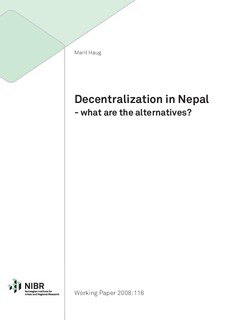| dc.contributor.author | Haug, Marit | |
| dc.date.accessioned | 2019-08-15T07:41:53Z | |
| dc.date.accessioned | 2021-04-29T13:56:59Z | |
| dc.date.available | 2019-08-15T07:41:53Z | |
| dc.date.available | 2021-04-29T13:56:59Z | |
| dc.date.issued | 2008 | |
| dc.identifier.isbn | 978-82-7071-743-9 | |
| dc.identifier.issn | 0801-1702 | |
| dc.identifier.uri | https://hdl.handle.net/20.500.12199/2504 | |
| dc.description.abstract | Last ned gratis This paper describes the background to the current debate on federalism in Nepal. Political, civil society, ethnic, and community-based mobilization in Nepal has created strong pressure on the Constitutional Assembly to deliver a federal solution that will allow the divers ethnic and caste groups of Nepal to be represented in governance institutions at different levels, and to have equal access to services, infrastructure and economic opportunities. The paper argues that there is a need to think in terms of a three-tier federal system, where the third, local layer of governance will safeguard the rights of minority groups within federal states and continue the participatory development tradition through working closely with communities. Existing governance institutions at the sub-national level have been considerably weakened during the conflict and there is a need for a long-term, flexible plan for strengthening sub-national governance capacities. Tilknyttet prosjekt Oppsummering av NIBRs arbeid med Desentralisering i Nepal | no_NB |
| dc.publisher | Oslo: Norsk institutt for by- og regionforskning | |
| dc.relation.ispartofseries | NIBR-notat 2008:116 | |
| dc.subject | NIBR, PublikasjonerNIBR, Notat_NIBR | |
| dc.title | Decentralization in Nepal - what are the alternatives? | no_NB |
| dc.type | Notat | |
| fagarkivet.author.link | Haug, Marit;https://www.oslomet.no/om/ansatt/marhau | |
